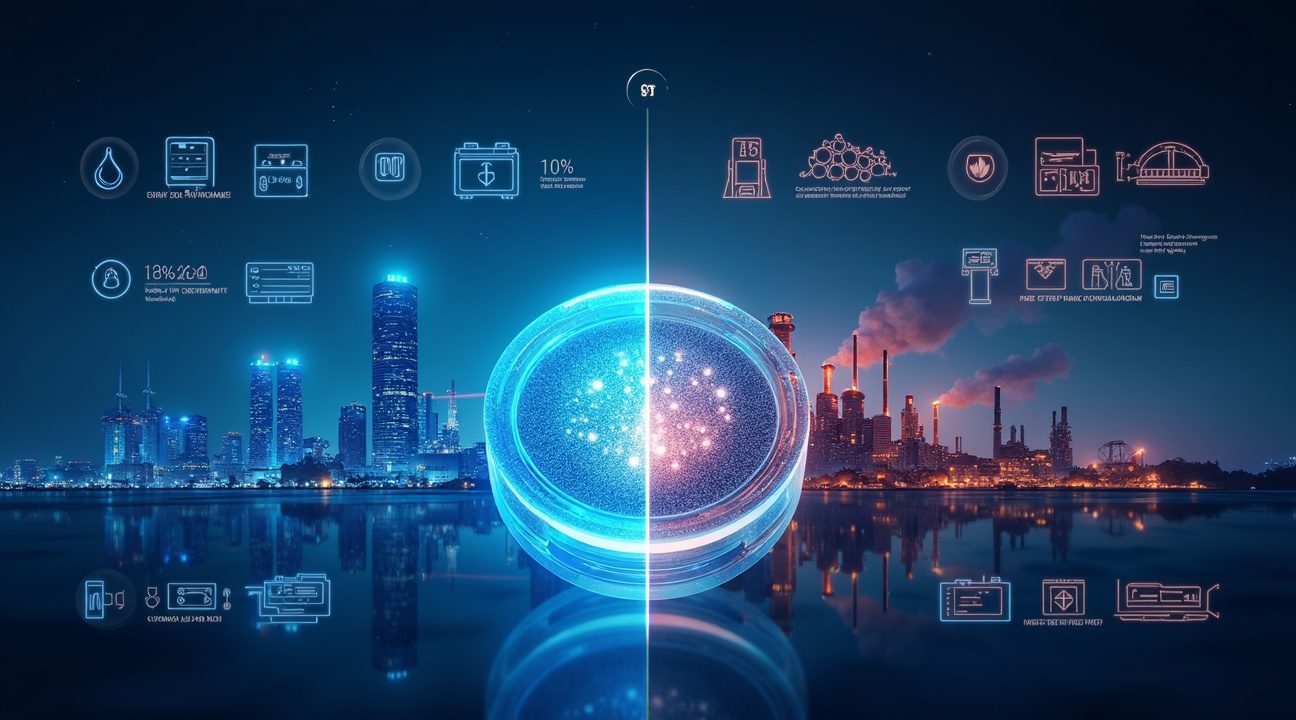Switzerland’s Revolutionary Crystal Battery Technology
Switzerland has developed a revolutionary crystal battery technology that utilizes synthetic radioactive crystals to generate continuous electricity for hundreds of years without requiring any external charging.
This groundbreaking innovation could transform global energy infrastructure by providing self-sustaining power sources that eliminate the need for traditional battery replacements and charging infrastructure.
Key Takeaways
- Continuous power generation: The crystal batteries use radioactive isotope decay to produce electricity for centuries without degradation or the need for recharging, unlike conventional batteries that require frequent charging cycles.
- Universal applications: The technology scales from coin-sized units for smartphones to industrial installations capable of powering entire communities, vehicles, and space missions with lifetime energy independence.
- Environmental benefits: Crystal batteries incorporate recycled nuclear waste as fuel material while eliminating battery replacement waste, potentially reducing the 15,000 tons of annual battery waste projected by 2040.
- Superior performance: Compared to traditional lithium-ion batteries that last 3–10 years, crystal batteries operate continuously for hundreds of years with sealed, safe designs that eliminate fire risks and thermal runaway dangers.
- Global energy transformation: The technology could provide energy independence for developing nations and remote locations while enabling distributed power networks that operate independently of centralized electrical grids.
How Crystal Battery Technology Works
This Swiss breakthrough represents a fundamental shift in how energy storage systems function. Traditional batteries store energy temporarily and deplete over time. Crystal batteries generate their own power through controlled radioactive decay processes. The synthetic crystals maintain their energy output consistently across multiple centuries.
The manufacturing process involves creating specialized crystalline structures that contain carefully controlled radioactive isotopes. These materials emit particles that convert directly into electrical current through advanced semiconductor interfaces. The entire system operates within sealed containers that prevent any radioactive material from escaping.
Safety protocols ensure these devices pose no health risks to users. The radiation levels remain far below natural background radiation found in everyday environments. Multiple containment barriers protect the radioactive material while allowing electricity to flow freely through insulated connections.
Advantages Over Traditional Batteries
Energy density exceeds current lithium-ion technology by significant margins. A smartphone-sized crystal battery produces enough power to run the device continuously for decades without any performance decline. Larger installations can supply steady electricity to homes, businesses, or industrial facilities for centuries without maintenance.
Installation requires minimal infrastructure compared to conventional power systems. Crystal batteries connect directly to existing electrical networks without complex charging stations or fuel delivery systems. Remote locations gain access to reliable power without expensive grid connections or fuel transportation costs.
Environmental and Economic Impacts
The technology addresses critical environmental concerns associated with battery waste. Current lithium-ion batteries require rare earth mining and create substantial disposal challenges. Crystal batteries use recycled nuclear waste as their primary fuel source, converting problematic materials into useful energy resources.
Economic implications extend far beyond energy savings. Developing regions can establish modern electrical infrastructure without massive capital investments in traditional power plants. Island nations and remote communities gain energy independence that previously required expensive fuel imports or unreliable renewable systems.
Applications Across Industries
- Space exploration: Satellites and space stations can operate for decades without battery degradation or solar panel maintenance.
- Deep space missions: Missions gain reliable power sources that function regardless of solar radiation availability.
- Medical devices: Pacemakers and other implants could last a patient’s lifetime without surgical battery replacement.
- Emergency equipment: Devices maintain full functionality during extended power outages or natural disasters.
Market Outlook and Challenges
Manufacturing costs remain higher than conventional batteries initially, but lifetime value calculations favor crystal technology significantly. The absence of replacement costs and maintenance requirements creates substantial long-term savings for users across all applications.
Regulatory frameworks will need updates to accommodate this new technology safely. International standards for radioactive material handling apply, but existing protocols already address similar containment requirements. Transportation and disposal regulations require adaptation for widespread commercial deployment.
Competition from established battery manufacturers will intensify as crystal technology matures. Lithium-ion producers face potential market disruption if crystal batteries achieve cost parity with traditional solutions. Investment patterns will likely shift dramatically as energy companies recognize the transformative potential.
Ongoing Research and Development
Research continues on improving power output density and reducing manufacturing complexity. Scientists work on optimizing crystal structures for specific applications while maintaining safety standards. Production scaling remains the primary challenge for widespread adoption.
Conclusion
The Swiss innovation positions crystal battery technology as a genuine alternative to current energy storage limitations. Continuous power generation eliminates range anxiety for electric vehicles and provides reliable backup power for critical infrastructure. This advancement could reshape global energy markets within the next decade.
For further information, you can follow developments through various energy technology news portals such as https://www.energy.gov.
How Synthetic Radioactive Crystals Generate Continuous Electricity for Hundreds of Years
The revolutionary crystal battery leverages synthetic radioactive crystals that transform isotope decay into a constant stream of electricity. This groundbreaking approach fundamentally changes how I think about long-term energy storage by eliminating the need for any external charging infrastructure.
The Science Behind Isotope Decay Technology
The synthetic radioactive crystals at the core of this system capture energy from natural atomic decay processes. As radioactive isotopes break down over time, they release particles and energy that the advanced crystal chemistry converts directly into usable electricity. This nonstop electricity generation continues for centuries because the decay process happens at a predictable, steady rate that scientists can harness with remarkable energy conversion efficiency.
Unlike conventional rechargeable batteries that lose capacity over repeated charging cycles, these crystals maintain stable power output throughout their operational lifetime. The sealed battery design completely contains all radioactive materials, creating a self-contained energy system that operates in complete silence. This silent energy generation makes the technology suitable for applications where noise pollution would be problematic.
The manufacturing process can incorporate recycled nuclear waste, transforming what was once a disposal challenge into valuable energy resources. This radioactive waste recycling approach addresses two critical issues simultaneously:
- Reducing nuclear waste stockpiles
- Creating clean energy solutions
The continuous electricity flow from these batteries remains constant regardless of weather conditions, temperature fluctuations, or other environmental factors that typically affect renewable energy systems.
Each battery unit functions independently without requiring maintenance, monitoring systems, or replacement components for hundreds of years. The sealed construction prevents any radioactive material from escaping while maximizing the conversion of decay energy into electrical output. This self-sustaining design means communities could install these systems once and rely on them for multiple generations without intervention.
The stable power output characteristics make these batteries ideal for critical infrastructure that demands uninterrupted electricity supply. Emergency systems, medical facilities, and communication networks could benefit from this technology’s reliability and longevity. The crystals maintain their energy conversion efficiency throughout their operational period, ensuring consistent performance from installation through eventual decommissioning centuries later.

Revolutionary Applications From Smartphones to Space Missions
The crystal battery breakthrough promises to reshape how people interact with technology across every sector. I can envision a future where the constant anxiety of a dying phone battery becomes a distant memory, as these coin-sized power units deliver lifetime energy to smartphones without a single charging session.
Personal and Automotive Applications
Smartphone users will experience unprecedented freedom with crystal batteries smaller than a quarter providing continuous power throughout the device’s entire lifespan. This advancement eliminates the daily ritual of searching for charging cables and power outlets. Car manufacturers are already exploring automotive applications, where crystal battery units could make public charging stations obsolete. Electric vehicle owners would purchase cars with permanently installed power systems, removing range anxiety and infrastructure concerns that currently limit EV adoption.
The automotive transformation extends beyond personal vehicles. Commercial fleets, emergency services, and long-haul transportation could operate with complete energy independence. Fleet managers won’t need to plan routes around charging stations or schedule downtime for battery maintenance.
Global Infrastructure and Space Exploration
Remote village electrification represents one of the most significant humanitarian applications of this technology. Industrial-scale crystal battery installations can power entire communities for generations, bringing electricity to regions where traditional grid infrastructure remains economically unfeasible. These communities will gain access to refrigeration, lighting, communication systems, and educational technology that transforms quality of life.
Space exploration stands to benefit dramatically from crystal battery technology. Current missions face severe limitations due to power constraints, relying on solar panels that degrade over time or nuclear systems with finite fuel supplies. Crystal batteries could enable spacecraft to operate for centuries without power degradation, opening possibilities for deep space exploration missions that were previously impossible. Mars rovers could function indefinitely, while interstellar probes could maintain communication systems throughout multi-decade journeys.
The technology addresses fundamental energy independence challenges facing developing nations. Countries currently dependent on energy imports could achieve complete energy sovereignty through distributed crystal battery installations. Rural hospitals, schools, and communication networks could operate continuously without connection to unreliable power grids. Manufacturing facilities in remote locations could function with guaranteed power availability, enabling economic development in previously isolated regions.
Emergency response capabilities would transform completely with portable crystal battery units providing immediate, long-term power restoration following natural disasters. Relief organizations could establish communication centers, medical facilities, and temporary shelters with reliable energy sources that function regardless of damaged infrastructure.

Crystal Battery Versus Traditional Technologies: A Complete Performance Comparison
The revolutionary crystal battery technology emerging from Switzerland presents a dramatic departure from conventional energy storage systems, delivering performance characteristics that completely redefine what’s possible in portable and grid-scale power generation.
Performance Metrics That Change Everything
Lifespan differences between crystal batteries and traditional technologies reveal the most striking advantage. Crystal batteries operate continuously for hundreds of years without degradation, while conventional lithium-ion batteries typically last just 3–10 years before requiring replacement. Even the most advanced solid-state batteries project lifespans of only 10–15 years, making them temporary solutions compared to crystal technology’s permanent energy generation.
Recharge Requirements
Recharge requirements expose another fundamental difference in how these systems function:
- Crystal batteries never require external charging, generating power continuously throughout their operational lifetime
- Conventional lithium-ion batteries demand daily charging for most applications
- Solid-state batteries, despite improved efficiency, still need weekly charging cycles
- Traditional systems lose capacity over time, requiring more frequent charging as they age
Energy Delivery Mechanisms
Energy delivery mechanisms separate crystal batteries from all existing alternatives. Crystal batteries generate power continuously through radioactive decay processes, providing steady output without the energy storage limitations that plague traditional battery systems. Conventional batteries store finite amounts of energy that drain with use, creating the constant cycle of discharge and recharge that defines current portable electronics and electric vehicle experiences.
Size and Form Factor Advantages
Size advantages become apparent when comparing practical applications. Coin-sized crystal batteries deliver lifetime energy generation, eliminating the need for larger battery packs or charging infrastructure. Traditional batteries require significant size increases to extend runtime, yet still demand regular charging regardless of their physical dimensions.
Safety Profile and Risk Reduction
Safety profiles distinguish crystal technology through sealed, contained designs that eliminate the thermal runaway and fire risks associated with lithium-ion systems. The contained radioactive materials in crystal batteries pose no external radiation threat, while conventional batteries carry well-documented risks of overheating, swelling, and combustion under stress conditions.
Environmental Impact
Environmental considerations favor crystal batteries through their innovative use of recycled nuclear waste as fuel material. This approach transforms existing radioactive materials into productive energy sources rather than long-term storage problems. Conventional battery production depends heavily on mining operations for lithium, cobalt, and rare earth elements, creating substantial environmental disruption and supply chain vulnerabilities.
Scalability and Infrastructure
Scalability ranges from tiny coin-sized applications to massive industrial installations without requiring supporting charging infrastructure. Traditional battery systems, regardless of their scale, still demand extensive electrical grid connections and charging facilities to maintain operation. Crystal batteries operate independently once installed, making them ideal for remote locations, space applications, and developing regions without reliable electrical infrastructure.
To learn more about the capabilities and development of crystal batteries, view this video:
https://www.youtube.com/watch?v=PUe6X2vWeRk

Switzerland’s Battery Innovation Hub and Industry Leadership
Switzerland has emerged as a formidable force in battery technology development through strategic investments in cutting-edge infrastructure and innovative startups. The Swiss technology innovation center CSEM inaugurated Switzerland’s first dry room as part of the Battery Innovation Hub, which became operational in September 2025. This facility represents a significant leap forward in Swiss research capabilities, offering unprecedented manufacturing conditions that remain unparalleled among Swiss research institutions and universities.
Advanced Battery Technologies and Manufacturing Capabilities
The dry room facility enables Switzerland to advance solid-state lithium-metal battery development, which promises higher energy density, lower costs, faster charging times, and improved safety compared to conventional battery technologies. These characteristics position Swiss-developed batteries as potential game-changers for large-scale energy storage applications.
BTRY, a Zurich-based startup founded in 2023, demonstrates the country’s entrepreneurial strength in battery innovation. The company received CHF 150,000 in grant funding from Venture Kick in July 2024 to produce first-generation battery products on a pilot line. BTRY’s impressive backing includes:
- High-Tech Gründerfonds (HTGF)
- Zürcher Kantonalbank (ZKB)
- European Space Agency incubator (ESA BIC Switzerland)
- Runway incubator
This brought their total funding to CHF 1.1 million.
The canton of Solothurn exemplifies Switzerland’s comprehensive approach to battery technology by collaborating with Switzerland Innovation Park Biel/Bienne on automated battery recycling technologies. This partnership addresses the growing challenge of battery waste management while creating circular economy opportunities.
Swiss Battery Technology Center (SBTC) Solothurn GmbH is being established to handle the estimated 15,000 tons of electric vehicle batteries reaching end-of-life annually by 2040. This proactive approach ensures Switzerland will maintain technological leadership throughout the entire battery lifecycle, from manufacturing to responsible disposal and recycling.
The combination of state-of-the-art research facilities, innovative startups, and forward-thinking waste management positions Switzerland as a global leader in next-generation battery manufacturing. The country’s commitment to developing solid-state technologies alongside sustainable recycling solutions creates a foundation for breakthrough innovations that could revolutionize energy storage on a planetary scale.
Switzerland’s integrated approach brings together academic research, private investment, and government support to accelerate battery technology development. The dry room facility at CSEM provides the controlled environment necessary for producing advanced battery components, while startups like BTRY demonstrate the commercial potential of Swiss innovations.
These developments collectively establish Switzerland as a battery innovation powerhouse, capable of addressing both current energy storage challenges and future demands for sustainable, high-performance battery systems. The country’s focus on solid-state lithium-metal batteries, combined with comprehensive recycling infrastructure, creates synergies that could support revolutionary energy storage breakthroughs.
Global Energy Transformation and Market Revolution
Switzerland’s groundbreaking crystal battery technology stands poised to revolutionize the global energy landscape in unprecedented ways. This breakthrough innovation could completely dismantle the traditional battery replacement market by eliminating the need for recurring battery purchases entirely. Industries that currently rely on constant battery replacements would experience dramatic cost reductions and operational efficiency gains.
Environmental Impact and Waste Elimination
The environmental implications of this technology extend far beyond simple energy storage. Switzerland alone faces an estimated 15,000 tons of battery waste annually by 2040, highlighting a critical challenge that crystal battery technology directly addresses. By providing centuries of power without replacement, this innovation could virtually eliminate battery waste streams that currently burden recycling infrastructure and create environmental hazards.
Crystal batteries offer a sealed, safe design that removes common safety concerns plaguing traditional battery systems. Fire risks, toxic material handling, and hazardous disposal requirements become obsolete with this advanced technology. The quiet operation enables deployment in residential areas and sensitive environments without introducing noise pollution, making it suitable for urban applications where traditional generators would be impractical.
Global Energy Access and Independence
This technology could transform energy access for developing nations currently experiencing widespread power shortages. Countries struggling with unreliable electricity infrastructure could bypass traditional grid development entirely, implementing distributed crystal battery systems that provide consistent, long-term power solutions.
The truly portable, self-sufficient nature of these power sources enables complete energy independence for remote locations, disaster relief operations, and off-grid communities. Switzerland’s development of this technology positions the country as a global leader in next-generation energy storage, potentially creating new export markets and technological licensing opportunities.
Crystal battery deployment could fundamentally reshape global energy infrastructure by reducing dependence on centralized power grids. Distributed energy networks become feasible when individual power sources can operate independently for centuries without maintenance or replacement. This decentralization enhances energy security by creating redundant systems that can’t be disrupted by single points of failure.
The technology’s integration capabilities with renewable energy sources could accelerate the transition away from fossil fuels. Solar and wind installations paired with crystal batteries would provide consistent power output regardless of weather conditions or time of day. This combination addresses the intermittency challenges that have historically limited renewable energy adoption on a massive scale.
Switzerland’s innovation represents more than just an advancement in battery technology—it signals the beginning of a complete energy revolution. The implications extend across industries, from transportation and telecommunications to healthcare and emergency services, where reliable, long-term power sources could eliminate current operational constraints and enable new applications previously considered impossible.
Sources:
Swiss Chamber of Commerce and Industry in Japan (SCCIJ) – Switzerland Pushes Battery Innovation
The Knowledge Hub – Switzerland Unveils Crystal Battery That Can Power the World for Centuries No Recharge Needed
Innovation News Network – Single Crystal Electrode Breakthrough Boosts EV Battery Life
Wikipedia – Rechargeable battery
GreyB – Top 5 Solid-State Battery Startups to Watch in 2025
Wikipedia – Electric battery


